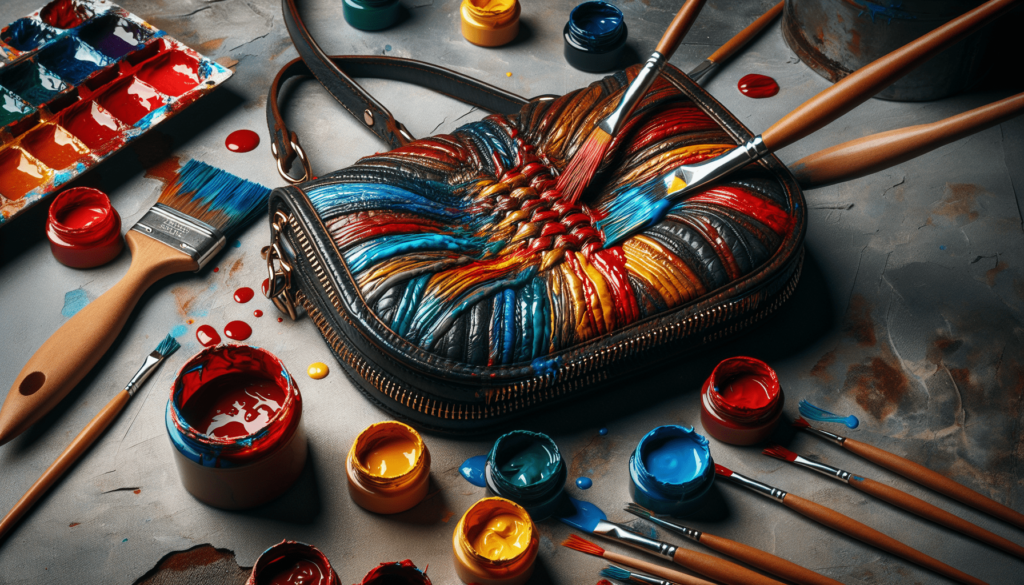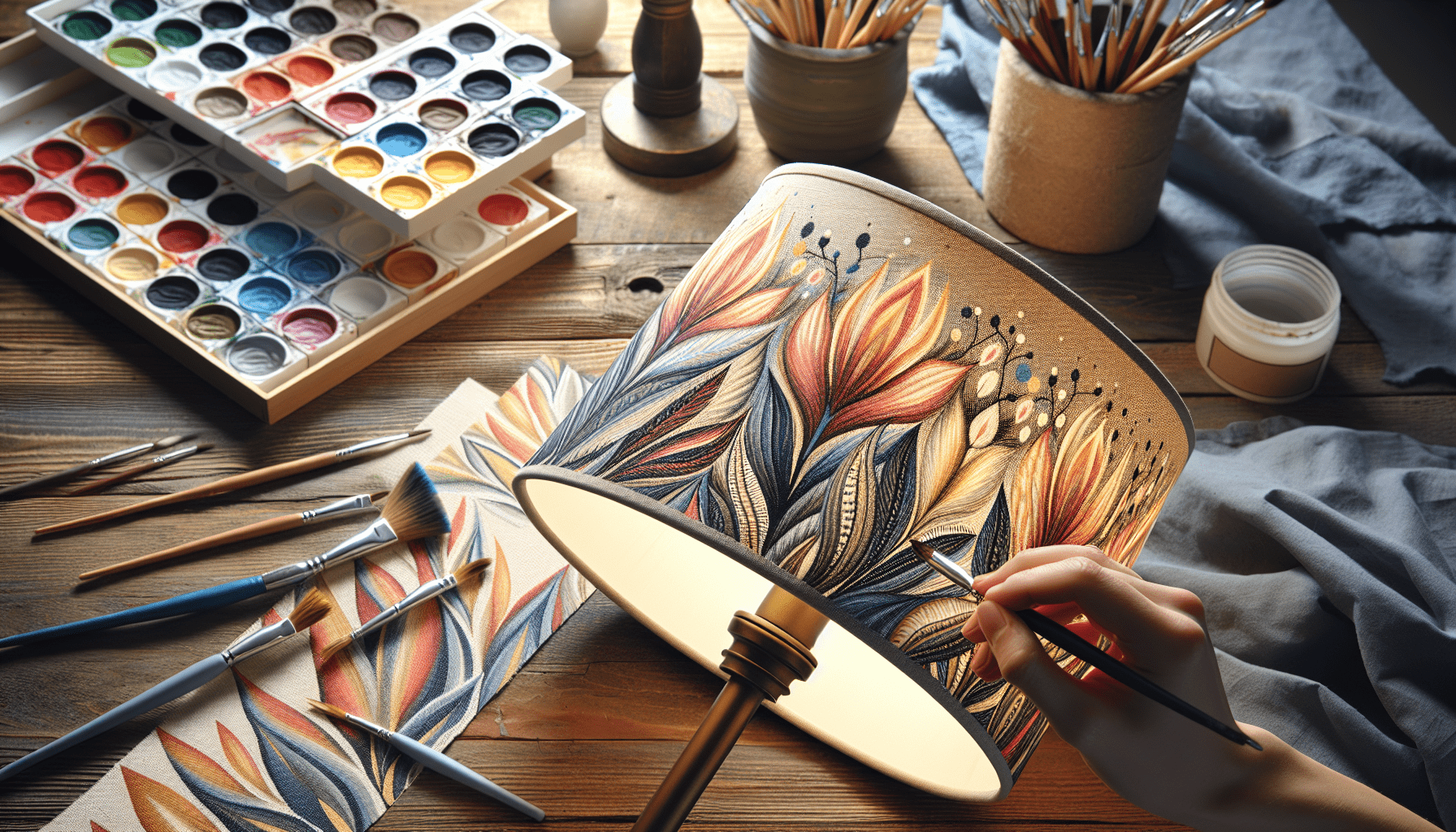Fabric paint is known for its versatility on various surfaces, but what about leather? Can this specialized paint bond successfully and create lasting designs on leather materials? This article explores the fascinating realm of fabric paint on leather, examining its compatibility, potential challenges, and the steps to achieve professional-looking results. Discover the secrets behind using fabric paint on leather and unlock a world of creative possibilities for your leather projects.
What is fabric paint?
Definition of fabric paint
Fabric paint is a type of paint specifically designed for use on fabric materials. It is a versatile medium that allows individuals to add color and designs to fabrics, transforming them into personalized, one-of-a-kind creations. Fabric paint typically comes in a liquid or paste form and can be applied to various types of fabric, such as cotton, polyester, and nylon.
Types of fabric paint
There are different types of fabric paint available on the market, each with its own unique characteristics and application methods. Some common types of fabric paint include:
-
Acrylic fabric paint: This type of fabric paint is water-based and offers vibrant colors with excellent coverage. It is easy to use, dries quickly, and remains flexible and durable on fabric. Acrylic fabric paint can be applied with a brush, sponge, or by screen printing.
-
Heat-set fabric paint: Heat-set fabric paint, also known as iron-on fabric paint, is designed to become permanent on fabric when heat is applied. This type of paint is ideal for projects that require washability and longevity. Heat-set fabric paint is commonly used for decorating clothing or accessories.
-
Puff fabric paint: Puff fabric paint creates a raised, three-dimensional effect on fabric. When applied, it expands when heated, creating a textured, puffy appearance. This type of fabric paint is often used for adding texture to designs or creating unique effects on fabric.
-
Metallic fabric paint: Metallic fabric paint contains metallic pigments, giving it a shiny and reflective finish. It can be used to add a touch of glamour and shine to fabric projects, such as clothing, home decor, or accessories.
Characteristics of fabric paint
Fabric paint offers several characteristics that make it suitable for use on various fabric materials. Some key characteristics of fabric paint include:
-
Flexibility: Fabric paint is formulated to remain flexible even after drying, allowing the fabric to stretch and move without cracking or peeling.
-
Washability: Most fabric paints are designed to be machine-washable, providing durability and longevity to painted fabrics. However, it is important to read the product instructions to ensure proper care and maintenance.
-
Colorfastness: Fabric paint is formulated to be colorfast, meaning the colors should remain vibrant and resistant to fading even after multiple washes.
-
Compatibility: Fabric paint is generally compatible with a wide range of fabric materials, including natural and synthetic fibers. However, it is important to consider the specific type of fabric and its compatibility with the chosen fabric paint.
-
Versatility: Fabric paint can be applied in various ways, including brush painting, screen printing, stenciling, and stamping. This versatility allows individuals to explore different techniques and create unique designs on fabric.
Understanding leather as a material
Definition of leather
Leather is a material made from the skins of animals, primarily cattle, sheep, or goats. It is known for its durability, strength, and unique characteristics. Leather is widely used in the production of clothing, accessories, furniture, and upholstery due to its natural beauty and resilience.
Properties of leather
Leather possesses several properties that differentiate it from other materials. These properties include:
-
Durability: Leather is highly durable and resistant to wear and tear. It can withstand regular use and maintain its quality for an extended period.
-
Breathability: Leather is a breathable material that allows air to pass through, making it comfortable to wear. This property also contributes to leather’s ability to regulate temperature.
-
Natural beauty: Leather exhibits a natural beauty and unique texture that adds an aesthetic appeal to products. The grain patterns and markings on leather can vary, further enhancing its visual appeal.
-
Strength: Leather is known for its strength and toughness. It has high tensile strength, making it resistant to punctures and tears.
-
Water resistance: Genuine leather has a certain degree of water resistance, thanks to its natural oils and the tanning process. However, it is important to note that leather is not entirely waterproof and can still be damaged if exposed to excessive moisture.
Why leather is often not compatible with fabric paint
Although fabric paint is suitable for various fabric materials, it is generally not recommended for use on leather. Leather has unique properties that make it incompatible with fabric paint. The main reasons why fabric paint may not work effectively on leather include:
-
Absorption and adhesion: Leather has a different surface texture and absorption rate compared to regular fabric. Fabric paint, especially water-based acrylic paints, may not adhere well to the surface of leather, resulting in poor adhesion and longevity of the paint.
-
Flexibility and movement: Leather is a flexible material that stretches and moves with use. Most fabric paints are not designed to withstand the constant flexing and stretching that leather undergoes, which can lead to cracking or peeling of the paint.
-
Drying and curing: Fabric paint requires specific drying and curing methods to ensure its adhesion and durability on fabric. Leather, however, may not provide the ideal conditions for the paint to dry and cure properly, leading to a compromised finish.
Considering these factors, it is crucial to explore alternative options specifically designed for use on leather if you wish to add color or designs to leather materials.

Considerations before using fabric paint on leather
Before attempting to use fabric paint on leather, it is essential to consider potential risks, compatibility issues, and proper preparation and testing. By following these considerations, you can minimize the chances of damage to the leather and achieve the desired results.
Risks and potential damage to leather
Using fabric paint on leather carries certain risks and potential damage that may compromise the appearance and integrity of the leather. Some of these risks include:
-
Poor adhesion: Fabric paint may not adhere properly to leather, resulting in a streaky or patchy appearance.
-
Cracking and peeling: Leather’s flexibility and movement can cause fabric paint to crack or peel over time, especially in areas that experience frequent bending or stretching.
-
Color bleed or transfer: Fabric paint may bleed or transfer onto other surfaces or fabrics when in contact, leading to unwanted color transfer or staining.
-
Alteration of texture: Applying fabric paint can alter the natural texture of leather, potentially resulting in a loss of its unique characteristics.
Compatibility issues
Fabric paint may not be compatible with certain types of leather or leather finishes. It is important to consider the type of leather you are working with and whether it is suitable for painting. Some types of leather that may not be compatible with fabric paint include:
-
Aniline leather: Aniline leather typically has a natural, untreated finish. The porous nature of aniline leather may result in poor paint adhesion and color absorption.
-
Patent leather: Patent leather has a glossy, lacquered finish that may not provide adequate adhesion for fabric paint.
-
Suede or nubuck leather: Suede and nubuck leathers have a soft, brushed texture that may not be suitable for painting with fabric paint, as it can result in a loss of the material’s original texture.
Consulting with leather experts or professionals can help determine the compatibility of fabric paint with the specific type of leather you wish to paint.
Preparation and testing
Proper surface preparation is crucial before applying fabric paint to leather. Some important steps to consider include:
-
Clean the leather: Thoroughly clean the leather surface using a mild leather cleaner or a mixture of warm water and mild soap. This step helps remove any dirt, oils, or residues that may prevent the paint from adhering properly.
-
Test the fabric paint: Before proceeding with the entire project, it is advisable to conduct a small, inconspicuous test on a hidden or less visible area of the leather. This test will help determine the adhesion, color absorption, and overall compatibility of the fabric paint with the leather.
-
Choose an appropriate workspace: Select a well-ventilated area with adequate lighting to ensure a comfortable and safe painting environment. Protect the surrounding surfaces with drop cloths or papers to prevent accidental paint splatters.
Seeking professional advice
If you have reservations or concerns about using fabric paint on leather, it is highly recommended to seek professional advice or consult with leather experts. Professionals can provide valuable insight, guidance, and alternative options that are specifically designed for painting leather. They can also offer suggestions for preserving the quality and longevity of your leather items.
Steps to use fabric paint on leather
If you have considered the risks, compatibility, and necessary preparations, you can proceed with using fabric paint on leather. The following steps outline the process of using fabric paint on leather effectively:
Surface preparation
Prepare the leather surface by following these steps:
-
Clean the leather: As mentioned earlier, clean the leather using a mild leather cleaner or a mixture of warm water and mild soap. Ensure that the surface is free from dirt, oils, or residues.
-
Sand the surface (optional): If the leather has a glossy or sealed finish, you may lightly sand it with fine-grit sandpaper to create a more receptive surface for the paint.
Choosing the right fabric paint
Select fabric paint that is suitable for use on leather. Consider using leather-specific paints or paints formulated to adhere well to various surfaces, including leather. These paints often have enhanced flexibility and durability, making them more compatible with leather.
Applying fabric paint on leather
Follow these steps to apply fabric paint on leather:
-
Use a brush or sponge: Apply the fabric paint onto the leather surface using a brush or sponge. Ensure even coverage and smooth strokes for a professional finish. You can also explore other application techniques, such as screen printing or stenciling, depending on your desired design.
-
Layering and drying time: Apply the paint in thin layers, allowing each layer to dry completely before applying subsequent layers. This step helps prevent the paint from becoming too thick or heavy, which could affect its adhesion and flexibility on leather.
Allowing for drying and curing
Once you have applied the fabric paint, allow it to dry thoroughly. Follow the manufacturer’s instructions for drying time, as it may vary depending on the specific type of fabric paint used. Proper drying ensures that the paint adheres to the leather surface securely.
Setting the fabric paint on leather
Some fabric paints require heat or additional steps to set properly on leather. Follow these guidelines to set the paint:
-
Heat-setting: If the fabric paint requires heat-setting, use an iron to apply heat indirectly to the painted leather surface. Place a protective layer, such as a cloth or parchment paper, over the painted area and use a warm iron to gently press the surface. This step helps bond the paint to the leather and enhances its durability.
-
Curing time: After heat-setting or completing the necessary steps, allow the fabric paint to cure for the recommended duration. Curing time allows the paint to fully dry and reach its maximum durability and appearance.

Alternatives to fabric paint for leather
If using fabric paint on leather is not feasible or if you are looking for alternative options, there are several other methods and products specifically designed for coloring or decorating leather. Some common alternatives to fabric paint for leather include:
Leather-specific paints
Various leather-specific paints are available on the market, which are formulated to adhere well to leather surfaces. These paints typically offer better compatibility, adhesion, and longevity when compared to fabric paint. Leather-specific paints come in a range of colors and finishes, allowing individuals to achieve desired effects on leather.
Leather dyeing
Dyeing leather is another option to add color and personalize leather items. Leather dyes are specifically made for coloring leather and offer excellent color penetration and adhesion. They can be used to achieve even and long-lasting color results on leather. It is important to note that leather dyeing requires careful surface preparation and may require multiple coats for desired color intensity.
Leather markers
Leather markers are an easy-to-use alternative for adding color or designs to leather. These markers contain specialized ink that is compatible with leather surfaces. Leather markers often provide good adhesion and color vibrancy, allowing for detailed and precise designs. They are particularly useful for smaller projects or intricate designs.
Leather stains
Leather stains offer a different approach to coloring leather items. Unlike paint or dye, leather stains penetrate the surface of the leather, enhancing its natural appearance while adding color. Leather stains come in various shades and can be used to achieve a vintage or distressed look on leather. The application process may vary depending on the specific stain, but it typically involves cleaning, applying the stain, and sealing with a protective layer.
Consider these alternatives based on your specific requirements, the type of leather, and the desired outcome to ensure the best results for coloring or decorating leather items.
Examples of fabric paint on leather
Successful examples of using fabric paint on leather
While fabric paint may not be the most compatible option for leather, some individuals have successfully used fabric paint to add color or designs to leather items. Examples of leather items that can be suitable for fabric paint include:
-
Leather accessories: Small leather accessories, such as wallets, keychains, or bracelets, can be painted using fabric paint to create personalized designs or patterns.
-
Shoes: Certain types of leather shoes, such as sneakers or canvas shoes with leather accents, may be suitable for fabric paint application. However, it is important to ensure proper surface preparation and compatibility before painting shoes.
Tips from experienced users
Experienced users who have used fabric paint on leather have shared several tips to achieve better results when attempting this method. Some of their recommendations include:
-
Test on a small area: Before painting the entire leather item, conduct a test on a small, inconspicuous area to assess the compatibility and adhesion of the fabric paint.
-
Use a primer (where applicable): If the leather item has an extremely smooth or non-porous surface, consider using a leather primer before applying the fabric paint. The primer can enhance adhesion and improve the longevity of the paint.
-
Thin paint layers: Apply fabric paint in thin layers to prevent excessive build-up and maintain flexibility on leather. Thin layers are less likely to crack or peel with frequent use.
-
Allow for curing time: Ensure that the fabric paint has enough time to dry and cure according to the manufacturer’s instructions. Rushing the drying process may compromise the integrity of the paint.
Creative ways to incorporate fabric paint on leather
While using fabric paint on leather may have limitations, individuals have found creative ways to incorporate fabric paint into their leather projects. Some ideas include:
-
Stenciling or stamping: Use fabric paint with stencils or stamps to create patterns or designs on leather items. This technique allows for precise and repeatable designs while adding a touch of personalization.
-
Color-blocking: Combine multiple colors of fabric paint to create color-blocked designs on leather. This technique can add visual interest and showcase different shades on the leather surface.
-
Textured effects: Experiment with different application techniques, such as dry brushing or sponging, to create textured effects with fabric paint on leather. These techniques can add depth and dimension to the painted leather surface.
Precautions and best practices
To ensure the best possible outcome when using fabric paint on leather, it is important to follow these precautions and best practices:
-
Avoid excessive paint application: Applying too much fabric paint can lead to heavy and thick layers that may crack or peel. Use thin layers and allow each layer to dry before applying additional coats.
-
Protect the surrounding areas: When painting leather items, particularly larger ones like jackets or furniture, use drop cloths or protective materials to prevent accidental paint splatters on nearby surfaces.
-
Consider the leather finish: Different leather finishes may have varying levels of compatibility with fabric paint. Consider the original finish of the leather and consult with professionals if in doubt.
-
Test durability and colorfastness: Even if successful, it is essential to test the durability and colorfastness of the fabric paint on a small area of the painted leather. This step ensures that the paint does not easily scratch off or transfer onto other fabrics.
Potential issues and limitations
While fabric paint on leather may provide satisfactory results for certain applications, it is crucial to be aware of potential issues and limitations associated with this method. Some of these limitations include:
Durability of fabric paint on leather
Fabric paint may not provide the same level of durability and longevity on leather as it does on fabric. Leather’s flexibility and constant movement can cause the paint to crack, peel, or wear off over time, especially in high-friction areas.
Color bleed or transfer
Fabric paint applied to leather may bleed or transfer when it comes into contact with moisture, such as rain or sweat. This can lead to unwanted color bleeding or staining on other surfaces or fabrics that come into contact with the painted leather.
Texture and flexibility alterations
The application of fabric paint on leather can potentially alter the natural texture of the leather, resulting in a loss of the material’s unique characteristics. Additionally, the paint can affect the flexibility and movement of the leather, leading to stiffness or discomfort.
Long-term effects on leather
The long-term effects of using fabric paint on leather are not fully known. Over time, the paint may break down, fade, or show signs of wear, potentially detracting from the original appearance of the leather. The use of fabric paint on leather may also affect the leather’s aging process and natural patina development.
Maintenance and care considerations
Leather treated with fabric paint may require special care and maintenance. It is important to follow the manufacturer’s instructions for cleaning and preserving the painted leather. Harsh cleaning agents or excessive exposure to moisture may compromise the integrity and longevity of the fabric paint on the leather.
Personal experiences and testimonials
Feedback from people who have used fabric paint on leather can provide valuable insights into the effectiveness and challenges associated with this method. Personal experiences and testimonials vary, as some individuals have achieved satisfactory results, while others have encountered issues such as poor adhesion, cracking, or color transfer.
Pros and cons shared by users
Users of fabric paint on leather have shared a range of pros and cons based on their personal experiences. Some common advantages and disadvantages mentioned include:
Pros:
-
Customization: Fabric paint on leather allows for customization, allowing individuals to create unique designs or color combinations on their leather items.
-
Cost-effective: Using fabric paint can be a more affordable option compared to purchasing new colored or patterned leather items.
-
Creative outlet: Fabric paint provides an artistic outlet for individuals to express their creativity and explore different design possibilities on leather.
Cons:
-
Durability concerns: Many users have expressed concerns regarding the long-term durability of fabric paint on leather, as it may not withstand regular use or wear.
-
Compatibility issues: Some individuals have experienced compatibility issues, with the fabric paint not adhering well to certain types of leather or finishes.
-
Texture and appearance alterations: The application of fabric paint can potentially alter the texture and aesthetic appearance of the leather, diminishing its natural beauty.
Lessons learned and recommendations
Based on the experiences of individuals who have used fabric paint on leather, several lessons and recommendations have emerged:
-
Surface preparation is crucial: Properly cleaning and preparing the leather surface is essential to ensure better adhesion and longevity of the fabric paint.
-
Test and experiment: Conducting small tests and experimenting with different techniques, paints, or markers on inconspicuous areas can help determine the compatibility and final appearance of the fabric paint on leather.
-
Seek professional advice: Consulting with leather experts or professionals can provide valuable guidance, recommendations, and alternative options for coloring or decorating leather items.
Conclusion
In conclusion, fabric paint is not the most compatible option for leather due to its unique properties and characteristics. While fabric paint can be successfully used on fabric materials, it may not adhere well to leather surfaces, leading to issues such as poor adhesion, cracking, or color transfer.
Alternatives to fabric paint, such as leather-specific paints, dyes, markers, and stains, offer better compatibility and results when coloring or decorating leather items. These alternatives are designed specifically for use on leather and are formulated to provide better adhesion, durability, and compatibility with the material.
Before considering fabric paint on leather, it is important to assess the risks, compatibility issues, and necessary preparations. Seeking professional advice and conducting proper testing can help minimize potential damage and achieve the desired results. Additionally, it is necessary to consider the limitations and maintenance considerations associated with using fabric paint on leather.
While personal experiences and testimonials may vary, fabric paint on leather should be approached with caution, understanding the potential risks and limitations. By considering alternative options specifically designed for leather and following best practices, individuals can achieve satisfactory results while preserving the natural beauty and integrity of their leather items.



